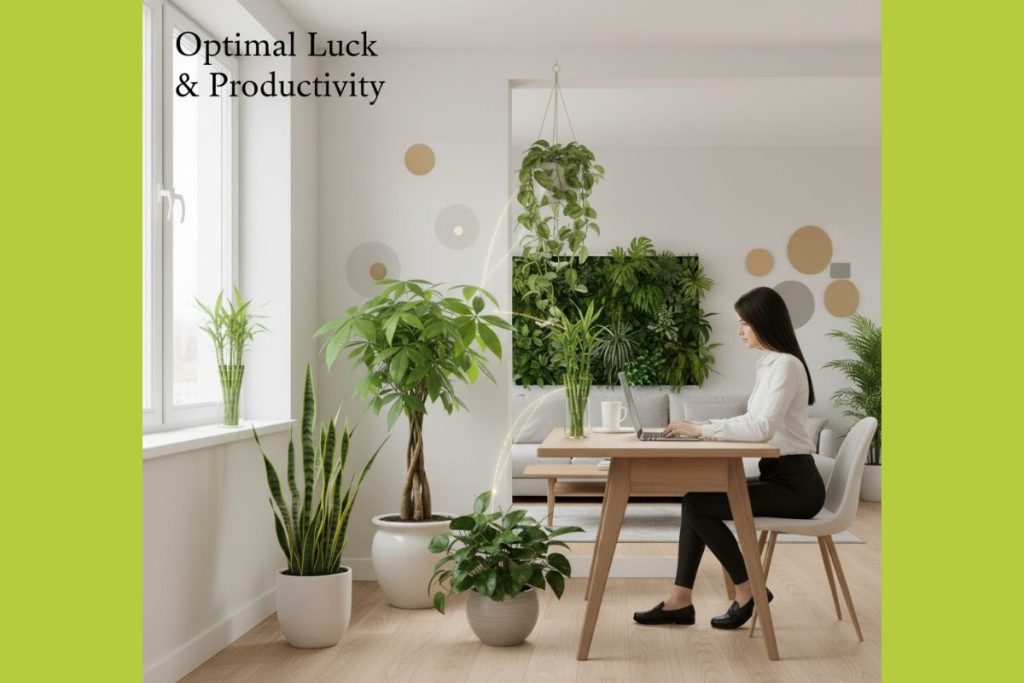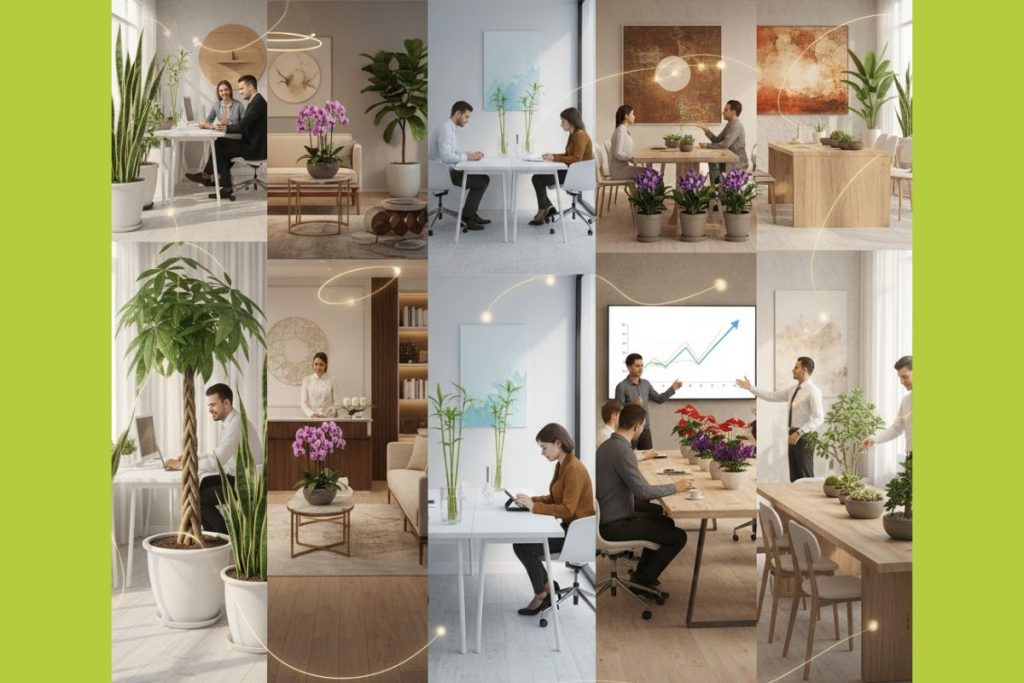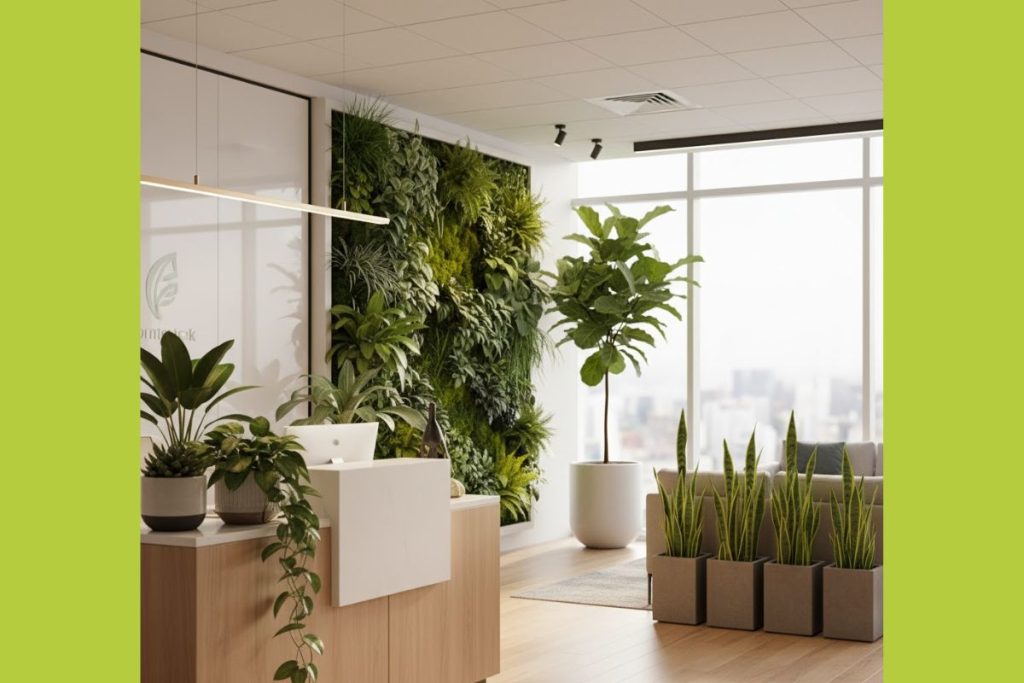There is a subtle but tangible shift in atmosphere when you walk into a space filled with plants. Your shoulders may drop slightly, you may breathe a little more deeply, and somehow the room just feels more alive. There’s something genuinely magical about adding greenery to indoor spaces, and whilst beautiful furniture and stunning artwork certainly contribute to a workspace, plants can often truly transform how a space feels with its uniquely natural element of the outdoors.
What if this wasn’t just about aesthetics, though? What if you could strategically position your office plants according to principles specifically designed to enhance prosperity, focus, and wellbeing? Welcome to the world of feng shui plants, where ancient Chinese wisdom meets modern workplace psychology.

Understanding Feng Shui: More Than Just Rearranging Furniture
Feng shui translates literally to “wind” and “water,” and it’s an ancient Chinese practice that uses energy forces to harmonise people with their surrounding environment. Before you dismiss this as mere superstition, consider what feng shui really addresses: the profound effect your surroundings have on your mental, physical, emotional, and spiritual wellbeing.
What Makes Feng Shui Relevant Today?
- Creates supportive environments that inspire joy and relaxation
- Addresses our innate need to connect with nature in built environments
- Provides tools for designing spaces that actively support wellbeing
- Aligns with contemporary biophilic design principles
Plants are a way to bring nature’s energy into our homes and interior environments, and in an energetic sense, they are very healing for us whilst practically improving air quality and beautifying our spaces.
The Bagua Map: Your Blueprint for Strategic Plant Placement
At the heart of feng shui practice is the Bagua map—an energy diagram that divides a building into nine areas, each representing a different aspect of life. Here’s where it gets particularly interesting for Australian offices:
| Direction | Element | Life Aspect | Best For |
| East | Wood | Health & Family | Workstations, health-focused areas |
| Northwest | Wood | Wealth & Prosperity | Reception, manager offices |
| North | Water | Career | Individual desks, study areas |
| South | Fire | Fame & Recognition | Meeting rooms, presentation spaces |
| Centre | Earth | Balance | Break rooms, communal areas |
Key Point for Australian Offices: Since Australia is in the Southern Hemisphere, the east is linked to health (wood element), and the northwest is linked to wealth (also a wood element). This gives you a practical framework for positioning plants to amplify specific intentions.
The wood element’s association with both health and wealth areas makes feng shui plants particularly powerful—plants are literally made of wood, so they naturally enhance these energies.

Science Meets Ancient Wisdom: The Psychology of Plant Placement
Let’s ground these principles in contemporary research, because the benefits of strategic plant placement go well beyond symbolism.
Plants Near Workstations: Boosting Focus and Productivity
The Research: Dr Craig Knight from Exeter University and his fellow psychologists, who studied the issue for 10 years, concluded that employees were 15% more productive when lean workplaces were enriched with just a few houseplants.
Placement Tips for Maximum Focus:
- Position plants within peripheral vision, not directly in your primary work field
- Use plants to create psychological boundaries around individual workspaces
- Choose smaller varieties like jade plants or compact snake plants for limited desk space
- Place larger plants strategically to reduce visual distractions in open-plan offices
Why It Works: Researchers found that enriching a lean office with plants could increase productivity by 15%, examining the impact on staff perceptions of air quality, concentration, and workplace satisfaction.
Plants in Break Areas: Creating Spaces for Restoration
Research consistently indicates that plants can improve air quality, reduce stress, improve mood, and enhance cognitive performance.
Best Plant Characteristics for Relaxation Spaces:
- ✓ Soft, rounded leaves (not spiky or angular)
- ✓ Lush, full foliage that invites visual exploration
- ✓ Flowing, cascading forms
- ✓ Subtle colour variations in green tones
Top Choices: Peace lilies with graceful white blooms, trailing pothos plants, or broad-leafed philodendrons create gentle, restorative atmospheres.
Plants in Meeting Rooms: Fostering Creativity and Collaboration
The Science: Research shows that people demonstrate more innovative thinking and generate more ideas and original solutions to problems in office environments that include flowers and plants.
Strategic Placement for Creativity:
- Position architectural plants that draw the eye upward to encourage expansive thinking
- Create clustered arrangements to foster collaborative energy
- Choose statement plants that stimulate without overwhelming
- Ensure plants enhance rather than dominate the conversation space
Recommended Plants: Rubber plants with bold, glossy leaves, or lucky bamboo arrangements that add visual interest.
The Best Feng Shui Plants for Office Success
🌿 Money Plant (Jade Plant)
Feng Shui Benefits: Promotes good fortune and prosperity, with coin-shaped leaves that attract wealth
Best Location: Northwest corner or near entrance
Care Level: Low-maintenance, perfect for busy professionals
Practical Benefits: Drought-tolerant succulent that symbolises resilience and steady growth
🎋 Lucky Bamboo
Feng Shui Benefits: Delivers tranquil vibes, associated with happiness and fortune
Best Location: East (health) or northeast (wealth) areas
Care Level: Very easy—thrives in water alone
Practical Benefits: Adapts to low light and cool temperatures, ideal for air-conditioned offices
Symbolism by Stalk Count:
- 3 stalks = Longevity, happiness, wealth
- 5 stalks = Wealth, balance, harmony
- 7 stalks = Good health
- 9 stalks = Good luck
🍃 Rubber Plant
Feng Shui Benefits: Attracts wealth and abundance, softens harsh angles
Best Location: Northwest corner (mentors and helpful people)
Care Level: Moderate—needs regular watering
Practical Benefits: Excellent air purifier with substantial visual presence
🗡️ Snake Plant
Feng Shui Benefits: Protective energy, shields against negative chi
Best Location: Entryways, corners, or near ceiling fixtures
Care Level: Virtually indestructible
Practical Benefits: Filters indoor air, requires minimal attention
Fun Fact: According to a 2024 LinkedIn Workplace Study, 73% of employees felt more satisfied in offices featuring indoor plants, with snake plants particularly prized.
🕊️ Peace Lily
Feng Shui Benefits: Converts negative energy to positive, promotes balance
Best Location: Stress-prone areas, near desks or meeting rooms
Care Level: Moderate—prefers consistent moisture
Practical Benefits: One of the best air-purifying plants, graceful white blooms add elegance

Quick Reference: Feng Shui Plant Placement Guide
| Office Area | Purpose | Best Plants | Feng Shui Zone |
| Reception/Entry | Welcome energy, prosperity | Money Plant, Lucky Bamboo | Northwest (wealth) |
| Individual Desks | Focus, productivity | Small Snake Plant, Jade Plant | East (health) |
| Break Room | Relaxation, restoration | Peace Lily, Pothos | Centre (balance) |
| Meeting Rooms | Creativity, collaboration | Rubber Plant, Lucky Bamboo | South (recognition) |
| Manager Offices | Leadership, mentorship | Rubber Plant, Large Snake Plant | Northwest (helpful people) |
| Open Plan Zones | Air quality, boundaries | Snake Plants, Palms | Varies by section |
Creating Your Optimal Workspace
The beauty of combining feng shui principles with modern plant placement strategies is that you’re addressing both tangible and intangible aspects of your workspace. You’re creating visual interest and improving air quality whilst simultaneously setting intentions and creating psychological boundaries that support different types of work.
The art of feng shui plant placement isn’t about rigid adherence to rules—it’s about creating environments that genuinely support your best work and wellbeing. By thoughtfully positioning office plants according to these time-tested principles whilst leveraging modern workplace psychology, you’re giving yourself every advantage for success, productivity, and perhaps even a bit of that elusive good luck we’re all chasing.
References
- Knight, C., & Haslam, S. A. (2014). “Why plants in the office make us more productive.” University of Exeter. Retrieved from https://news-archive.exeter.ac.uk/featurednews/title_409094_en.html
- Planteria Group. (2024). “Plants In The Office Make You 15% More Productive.” Retrieved from https://www.planteriagroup.com/blog/plants-in-the-office-make-you-15-more-productive/
- Society of American Florists. (2017). “Workplace Productivity Study.” Retrieved from https://safnow.org/aboutflowers/quick-links/health-benefits-research/workplace-productivity-study/
- Bringslimark, T., Hartig, T., & Patil, G. G. (2007). “Psychological Benefits of Indoor Plants in Workplaces: Putting Experimental Results into Context.” HortScience.
